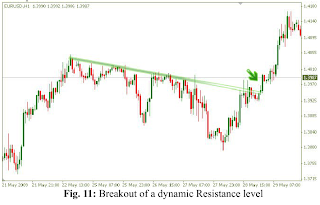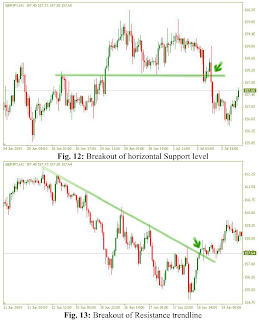Our trading decisions will be based on actions that price can perform in relation to trendlines. There are three scenarios that price can perform:
- Bounce
- Breakout
- Pullback
I will now explain each scenario and demonstrate in charts. Bounces Bounce occurs when price touches a Support or Resistance level and bounces in the opposite direction. These are strong signals that we will incorporate in our trading repeatedly. Examples for bounces were shown in the last pages:
Price bounced several times on these support and resistance levels. The more bounces – the stronger these levels are. We will only trade on levels that have at least 2 bounces. Levels with 1 bounce only are not strong enough to serve as trading signals.
Breakouts
Breakouts occur when price breaks a support or resistance level. They are usually accompanied with high volume and big movement of price. We will not trade these signals. Examples for breakouts:
Breakout signals attract many inexperienced traders that mistakenly think that the Breakout is a profitable signal.
Breakout is usually an unreliable signal whose continuation is doubtful. Price may appear to break a certain level but will close below it – this is known as 'Fakeout'. This happens a lot, especially when trading in small time-frames (Day Trading). When trading stocks, you can trade breakouts, though you will suffer from the same drawback these signals have.
This drawback is the inability of placing a stop loss at a logical location.
When entering on a breakout, we don't know where to place the stop loss, as price can retrace, touch our stop loss order (closing our trade) and continue in the original direction. In order to place a stop loss it must be far from price – thus decreasing our profitability.
We will now describe the main signal we will trade, one with highest power and reliability.
Pullbacks Pullbacks occur when price re-touches a Support\Resistance previously broken. This is one of the highest quality signals and we will trade them in many chart patterns. Examples for pullbacks:
Note that pullbacks should occur at few bars after the breakout. If the pullback doesn't occur quickly we will discard it as a potential trade. This is because psychological levels tend to lose their reliability as they became older. Always aim to trade newest trend lines and discard the old ones.
The pullback is an extremely strong trading signal, which results in frequent winning trades. This is empowered by the fact that when trading pullbacks, we are actually trading with the prevailing trend! The breakout that came before the pullback confirmed the strength of the trend – and enhances the quality of our signal. Next chapter When trade is confirmed












0 comments:
Post a Comment